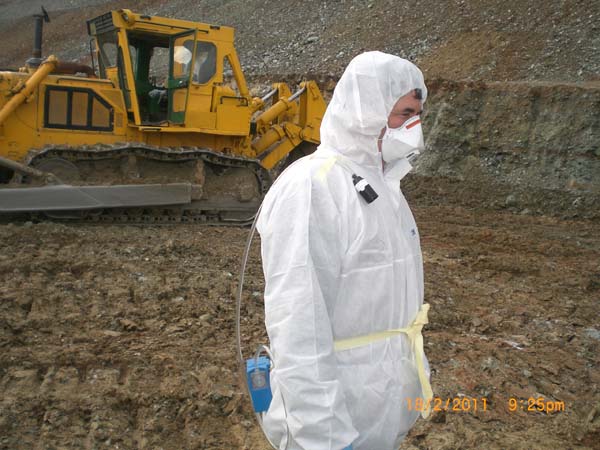Your Guide to Effective Asbestos Examining Procedures
Asbestos screening treatments are an essential part of making sure the security of indoor settings, particularly in older structures where this hazardous product may exist. The prospective health and wellness dangers connected with asbestos direct exposure make it vital to approach screening with precision and thoroughness. From understanding the homes of asbestos to properly translating test results, a comprehensive guide can outfit people with the knowledge and devices needed to browse this complex procedure. Remain tuned to reveal the necessary actions and considerations that can help you secure against the risks posed by asbestos.
Understanding Asbestos and Its Threats
Asbestos, a naturally happening mineral recognized for its warmth resistance and durability, presents extreme wellness threats when its fibers are breathed in or ingested. asbestos inspection. Direct exposure to asbestos can cause severe health conditions such as lung cancer cells, asbestosis, and mesothelioma. In spite of its beneficial buildings, asbestos has actually been commonly prohibited in lots of nations because of the tested web link in between asbestos direct exposure and these life-threatening diseases
When asbestos-containing materials are disrupted or harmed,The threat exists in the tiny fibers that can easily end up being airborne. When inhaled, these fibers can end up being lodged in the lungs, creating inflammation and scarring over time. The latency period in between direct exposure to asbestos and the advancement of relevant conditions can cover several years, making early detection and avoidance critical.
Asbestos was generally used in building materials, insulation, and auto parts before its health threats were completely understood. Today, appropriate screening and removal of asbestos-containing products are necessary to secure individuals from the threats connected with asbestos direct exposure.
Identifying Prospective Asbestos Products
The identification of potential asbestos materials is a critical action in making sure the safety of people exposed to dangerous materials in numerous environments. Asbestos can be located in a vast array of building products, consisting of yet not restricted to insulation, ceiling tiles, flooring ceramic tiles, concrete sheets, and roof covering tiles - asbestos survey near me. Identifying these materials precisely is necessary to properly managing the risks related to asbestos exposure

In situations where visual evaluation is undetermined, samples of believed materials can be collected and sent to approved laboratories for testing. These laboratories use specialized strategies such as polarized light microscopy or transmission electron microscopy to properly figure out the presence of asbestos fibers in the samples. By adhering to strenuous identification treatments, people can properly reduce the threats related to asbestos exposure.
Selecting the Right Screening Approach
Recognition of possible asbestos materials plays an important role in establishing the ideal testing approach for precise asbestos fiber detection. There Check Out Your URL are two main techniques for asbestos testing: polarized light microscopy (PLM) and transmission electron microscopy (TEM) It is crucial to consult with certified asbestos testing experts to identify the most ideal approach for your particular screening requirements.
Conducting Sample Collection Safely
When accumulating samples for asbestos screening, focusing on precaution is critical to minimize possible exposure threats. Asbestos fibers are hazardous when disrupted, making it essential to adhere to appropriate safety and security protocols throughout sample collection - Asbestos testing near me. Prior to starting the sampling process, ensure that you are furnished with individual protective devices (PPE) such as non reusable coveralls, handwear covers, goggles, and masks to protect against browse around this site inhalation or call with asbestos fibers
It is necessary to damp the sampling area making use of a mild mist of water to stop the fibers from ending up being air-borne during collection. When accumulating examples and avoid hostile scratching or piercing that could release asbestos fibers into the air, Usage care. Instead, meticulously cut a tiny piece of the material utilizing proper devices and position it right into a secured container for evaluation by a qualified laboratory.
Additionally, identifying each sample with comprehensive info relating to the tasting location, collector, and date's name is crucial for precise record-keeping and analysis. By following these safety and security standards, you can carry out example collection for asbestos testing effectively while minimizing the risk of direct exposure.
Analyzing Test Results and Following Steps

Conclusion
In conclusion, efficient asbestos testing treatments are important in recognizing and handling possible health threats connected with asbestos direct exposure. By comprehending the risks of asbestos, identifying possible products, choosing the best screening method, performing sample collection safely, and translating examination results properly, individuals and companies can take the required actions to safeguard themselves and others from the harmful impacts of asbestos. It is critical to prioritize security and proper testing procedures to make sure a healthy and balanced setting for all.

Recognition of possible asbestos materials plays an essential role in establishing the ideal screening method for accurate asbestos fiber discovery. The test outcomes will show the visibility or absence of asbestos, the kind of asbestos fibers existing, and the concentration levels.In conclusion, reliable asbestos screening treatments are necessary in determining and managing possible health risks linked with asbestos direct exposure. By comprehending the threats of asbestos, determining possible products, choosing the ideal testing technique, conducting example collection safely, and analyzing test results properly, individuals and organizations can take the necessary steps to protect themselves and others from the hazardous impacts of asbestos.